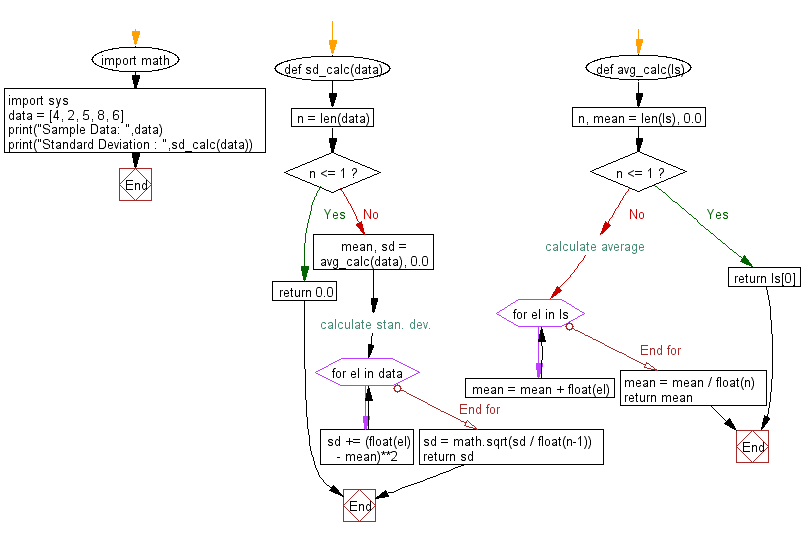
#Python calculate standard error how to
This above worksheet helps you to understand how to perform standard error calculation, when you try such calculations on your own, this standard error calculator can be used to verify your results easily. You don't use sample standard deviation of the sample means. Since you don't have access to population standard deviation, you use sample standard deviation. Normally, you would calculate that by dividing population standard deviation over n. Standard error of the mean is the standard deviation of all sample means. Understand more about Standard Deviation using this Standard Deviation Worksheet or it can be done by using this Standard Deviation Calculator The formula to calculate Standard Error is, Y_resample = np.array(random.Standard Error is a method of measurement or estimation of standard deviation of sampling distribution associated with an estimation method.

def extract_data_from_confusion_matrix(confusion_matrix):įor i, row in enumerate(confusion_matrix): Another approach is to directly calculate 2.5 and 97.5 percentiles ( np.percentile) of the bootstrapped CQK scores as your confidence interval. Using this approach, I get a standard error around 0.057, from which you know how to find the confidence interval. The standard deviation of this bootstrapped CQK sample is the standard error of the mean CQK score. Compute new CQK scores in this way a number of times, at least 100. Run these resampled predictions through the CQK score calculation, and you will get a new CQK score. To bootstrap sample the CQK score, resample with replacement from your set of predicted ratings. Since I don't know anything about Cohen's Quadratic Kappa beyond what you have written, I would fall back to the bootstrap method. These statistics functions are part of the Python Standard Library in the statistics module. Margin = (1 - alpha) / 2 # two-tailed test In this post, we'll look at a couple of statistics functions in Python. The 95% confidence interval then is just straightforward: alpha = 0.95 Sek = sqrt((numerator * (1 - numerator)) / (total * (1 - denominator) ** 2))Ĭan I use the total number of predictions, even though I calculate with a normalized numerator and denominator? This would result in a standard error of kappa of 0.023. # e: denominator (expected agreement by chance) # p: numerator (actual observed agreement) Now to my question: I need to calculate the standard error, in order to calculate the confidence interval. Numerator += weights * confusion_matrix_normĭenominator += weights * expected_normĬohen's Kappa can now be calculated as: weighted_kappa = (1 - (numerator/denominator)) Now I calculate the numerator (actual observed agreement) and the denominator (expected agreement by chance): for r in range(rows): Check resLogit.classes to make sure that sklearn ordered your classes as expected predProbs resLogit.predictproba(Xtrain) Design matrix - add column of 1's at the beginning of your Xtrain matrix Xdesign np.hstack(np.ones((Xtrain.shape0, 1)), Xtrain) Initiate matrix of 0's, fill diagonal with each predicted observation's variance V np.diagflat(np.product(predProbs, axis1)) Covariance matrix Note that the -operater does matrix multiplication in Python 3.5+, so if.

This matrix, and the actual confusion matrix, are normalized: expected_norm = expected / expected.sum()Ĭonfusion_matrix_norm = confusion_matrix / confusion_matrix.sum() The expected prediction quality by mere chance is calculated as follows: expected = np.outer(hist_actual, hist_prediction) Hist_prediction = np.sum(confusion_matrix, axis=1) Hist_actual = np.sum(confusion_matrix, axis=0) I calculate a weight matrix and histograms: weights = np.zeros((rows, cols)) This is my confusion matrix: # x: actuals, y: predictions I use NumPy and Scipy Stats for this purpose: from math import sqrt

Let's walk through my example (I use a smaller data set for the sake of simplicity).

What is missing, however, is how to calculate the confidence interval. I found this Python tutorial on how to calculate Cohen's Quadratic Kappa. One of the evaluation metrics chosen is Cohen's Quadratic Kappa. I need to evaluate the performance of a machine learning application.


 0 kommentar(er)
0 kommentar(er)
